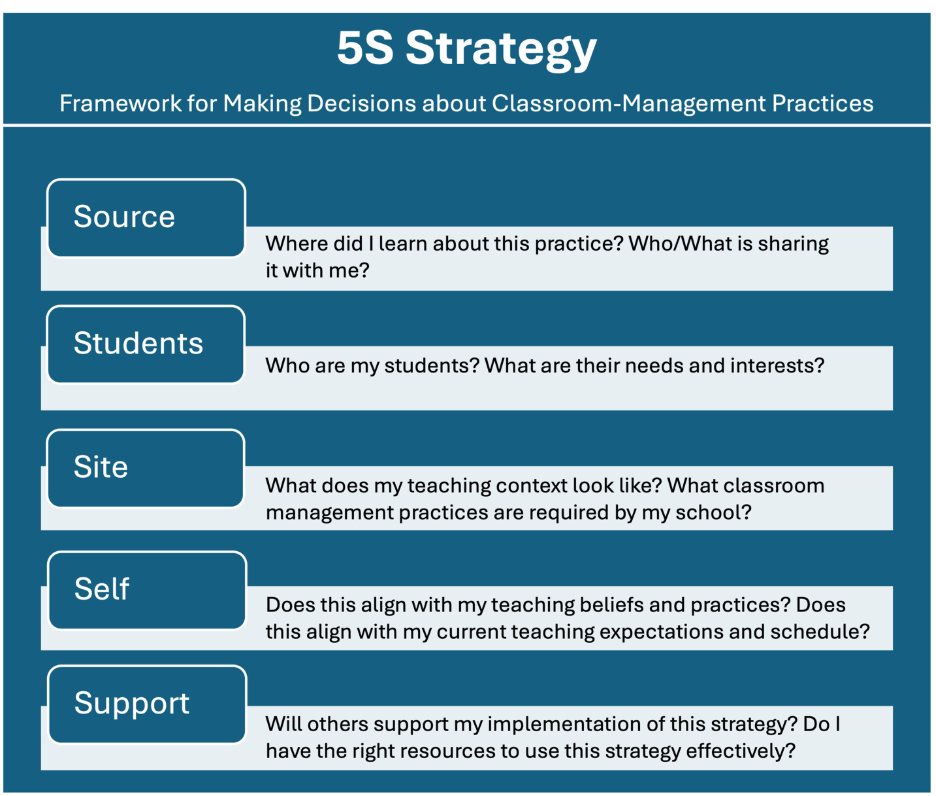Have you ever scrolled through TikTok, Reddit, or a teacher blog and found a fun classroom management idea? Do you think you need to refine your current classroom management strategies to better engage and support your students? Whether planning for the upcoming school year or trying to refine your current practices, you may go to social media to find new ideas for keeping students on-task and motivated. But how do you know if they are the right fit for your students?
Before implementing any new strategy, it’s important to assess whether practices found on social media are evidence-based practices (EBPs) that work well in your classroom. EBPs are strategies supported by research that improve student achievement, engagement, and appropriate behavior (Hirsch et al., 2021; Larson et al., 2021). One way to evaluate whether classroom management practices are evidence-based and a good fit for your context is by using the 5S Strategy: Source, Students, Site, Self, and Support. This model helps you reflect on your teaching context and evaluate new ideas more critically.

SOURCE
Where did I learn about this practice? Who/What is sharing it with me?
These questions help you evaluate the quality of the source. While some products promoted on social media are high quality, others may not be. Check whether the idea comes from a reputable source. If you’re unsure, compare it to strategies encouraged by trusted professional associations, such as Kappa Delta Pi, or organizations like the National Science Teaching Association and the National Association for the Education of Young Children. You can also explore evidence-based practices shared on university research center websites, such as Vanderbilt University’s IRIS Center (https://iris.peabody.vanderbilt.edu/pd-hours/earn-pd-hours/available-modules/)
STUDENTS
Who are my students? What are their needs and interests?
Reflect on your students both individually and collectively. Identify common classroom management issues that arise and consider whether the new strategy addresses them. While some strategies may work well for certain grade levels or student groups, they may not work for others. Keep age and interests in mind. For instance, tangible prizes like stickers may motivate elementary students but not high schoolers. Ask students about their interests through class discussions or surveys. Choose approaches that are respectful, meaningful, and relevant for your diverse learners, honoring who they are and what they bring to the classroom.
SITE
What does my teaching context look like? What classroom management practices are required by my school?
Your responses to these questions help you reflect on your teaching environment and school expectations. Consider the physical and procedural requirements for implementing the strategy. For example, do you have the space and resources to record points or store rewards? Check whether the strategy aligns with school policies and existing practices. If your school uses an app like ClassDojo to record behavior points, adding a separate ticket system could create confusion. Look for strategies that complement existing classroom, schoolwide, or district approaches to ensure alignment and consistency.
SELF
Does this align with my teaching beliefs and practices? Does this align with my current teaching expectations and schedule?
Consider your teaching philosophy, classroom goals, and time constraints. Reflect on whether the strategy or a combination of strategies fits your current structure. Does it require extra time, resources, and revisions to your schedule? Is this feasible for your class structure? Some teachers enjoy distributing and managing physical tokens, while others prefer digital tracking through apps or charts. Keep in mind the time required for maintaining the system and whether it’s sustainable. For example, trading tickets for rewards may require class time each week. Choose practices that fit your workflow and enhance, rather than disrupt, your classroom rhythm.
SUPPORT
Will others support my implementation of this strategy? Do I have the right resources to use this strategy effectively?
Reflect on the different layers of support you have and need to implement this approach. Identify the physical materials required and whether you already own them or need to purchase them. For example, will you need premade tickets and containers to store them? Determine whether funding is available to sustain the approach over time. You may also need collaboration or buy-in from colleagues, administrators, or families, for instance, to gather rewards or communicate expectations consistently.
To promote positive student outcomes, teachers should continually reflect on current practices and evaluate new ones thoughtfully. Before implementing any new classroom management strategy, consider the credibility of its source and whether it’s supported by evidence. By assessing how the strategy aligns with your district and school policies, available resources, teaching style, and students’ needs, you can select approaches that truly support learning and engagement in your classroom.
References
Hirsch, Shanna E., Kristina Randall, Catherine Bradshaw, and John Wills Lloyd. 2021. “Professional Learning and Development in Classroom Management for Novice Teachers: A Systematic Review.” Education and Treatment of Children 44 (4): 291–307.
Larson, Kristine E., Elise T. Pas, Jessika H. Bottiani, Joseph M. Kush, and Catherine P. Bradshaw. 2021. “A Multidimensional and Multilevel Examination of Student Engagement and Secondary School Teachers’ Use of Classroom Management Practices.” Journal of Positive Behavior Interventions 23 (3): 149–62.
The IRIS Center. 2025. “Resources.” Vanderbilt Peabody College. https://iris.peabody.vanderbilt.edu/resources/.
|
|
Dr. Deaton is an associate professor at Clemson University and former high school science teacher. Her work focuses on STEM professional development, teacher preparation, teacher research, and reflective practice. |
|
|
Dr. Beahm is an assistant professor at Clemson University and former elementary special education teacher. Her work focuses on supporting teachers in implementing effective classroom management practices. |